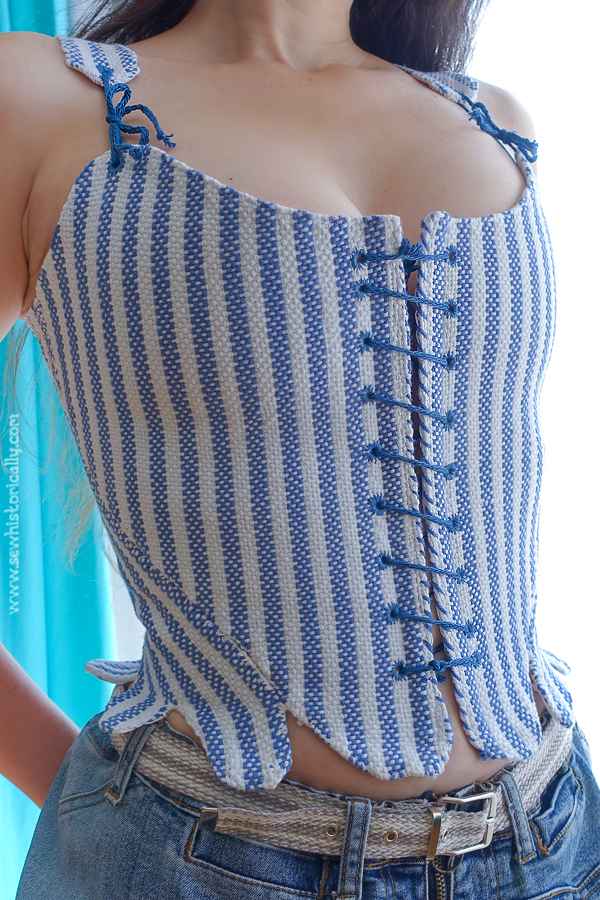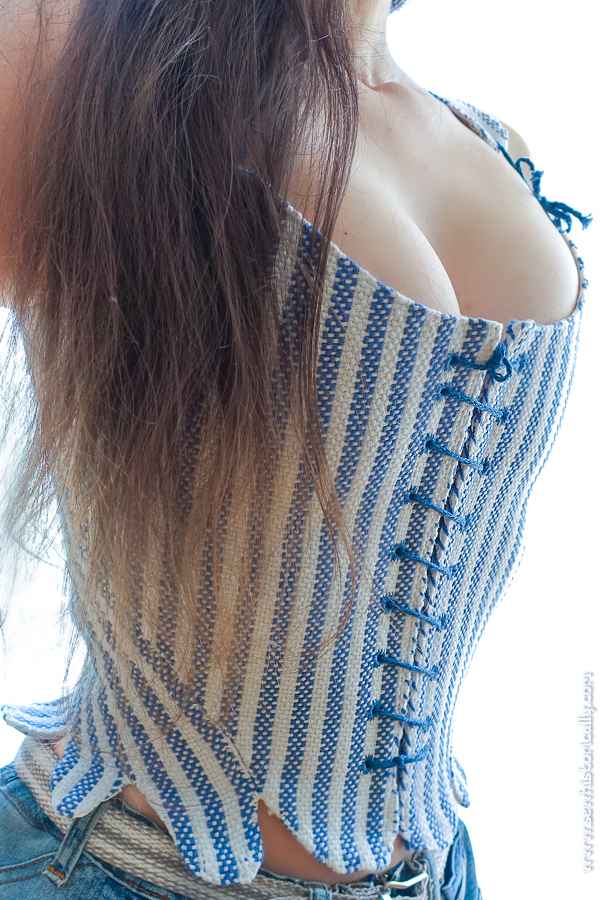Because it was so much fun making my handwoven dress and my handwoven corset top from scratch, I now wove fabric for a new handwoven clothing project: handwoven 18th century stays! 😀
I used blue and white cotton yarn from my stash. And it was surprisingly quick to weave the blue and white striped fabric for my handwoven 18th century stays.
Related: Handwoven Corset Top
‘Now it is spring […] All this winter I have been spinning flax and tow to make some summer clothes […] made me one home-made dress for everyday. It was cotton warp colored blue and copper and filled with pale blue tow filling so it was striped one way and was almost as nice as gingham.[…] I am going to try and make me one dress every year then I can have one for nice’ (Keturah Belknap, 1840s).
Historically Accurate Or Historybounding?
First of all, my handwoven 18th century stays are not historically accurate. They are a historybounding garment. The handwoven stays are inspired by 18th century stays but lack details that would make them historically accurate! 😉
Related: Modern 18th Century Recycled Denim Stays – History Bounding
Why my handwoven 18th c. stays are not historically accurate:
- The fabric I wove on my rigid heddle loom is not fine enough for 18th century stays.
- I used cotton yarn to weave my fabric instead of silk, wool or linen.
- I used a combination of handsewing and machine sewing. 18th century stays were completely handsewn.
- Apart from linen yarn, I also used cotton yarn as sewing thread.
- The cotton yarn that I used to braid the lacing cords is mercerized. The mercerization process was not yet known in the 18th century.
- I used cotton lining fabric instead of linen fabric.
Historically accurate details:
- The pattern is based on two antique 18th century stays patterns in Jill Salen’s “Corset” book.
- I used 18th century handsewing stitches to sew the pieces of the stays together.
- I pieced my handwoven fabric together joining selvages with the old German stitch.
- The stays are closed with spiral lacing.
- I used linen thread which I dyed blue for the handsewn eyelets.
- I made fingerloop braided lacing cords.
- I finished each piece of the stays before I stitched them together.
- I reinforced the top of the slits between the tabs with overhand stitches like on these antique 18th century stays.
How I Hand Wove The Fabric For My 18th Century Stays
I had just enough blue and white cotton crochet yarn in my stash to weave the fabric piece for my 18th century stays. You need surprisingly little handwoven fabric for 18th century stays.
I used about 300g of yarn: 200g for the warp, and 100g for the weft. I wove the fabric on my rigid heddle loom with a striped warp. The blue and white stripes are 4 threads wide.
I warped the loom using the traditional (indirect) warping method which took just over an hour and a half. After using the direct warping method I now always use the indirect warping method because direct warping always took longer! 😉
And it took me 2 hours and 15 minutes to weave the whole piece of fabric. Total warp length (including loom waste and shrinkage) was 230cm and weft width was 26cm. After the wet finishing (fulling) the handwoven fabric, the piece of fabric measured 24cm x 185cm.
Later I wove a small piece of fabric on my backstrap loom for the shoulder straps of the stays.
18th Century Stays Pattern
I used the same pattern for my handwoven 18th century stays that I also used for all my other 18th century stays like my 18th century linen stays. The pattern is adapted from the 1750s stays and the 1790s brown jean corset in Jill Salen’s “Corset” book.
Related: 18th Century Linen Stays
18th Century Stays Or Jumps?
My handwoven 18th century stays are rather jumps than stays because they are only boned at the center front. I quilted the lining and the outer fabric of my handwoven corset together along the stripes to create small boning channels. At first I wanted to make lightly boned 18th century stays. But this quilting already stiffens a bodice quite a lot. So I finally decided to omit the boning – except for the two center bones – and make 18th century quilted jumps! 🙂
Related: Historical Peasant Woman Outfit: Unboned Stays, Bumroll & Corded Petticoat
Do I Like How My Handwoven 18th Century Stays Turned Out?
At first, I was excited about my new handwoven clothing project. And it was surprisingly fast to weave the fabric on my rigid heddle and backstrap loom! 😀 I could have made my handwoven 18th century stays in a couple of days. But I also wanted to film the making process. I borrowed several video cameras and tried several video editing software. And it took over a year to finally find video equipment and editing software that produced an acceptable video quality. So it took over a year until I could finally finish my handwoven 18th century stays.
And personally I get less and less enthusiastic about sewing projects the longer they take! 😉 It’s not the fault of the handwoven corset stays but technical difficulties with the filming and video editing that made the making process less fun for me. I like how the stays turned out but I didn’t like the delay in the making process.



